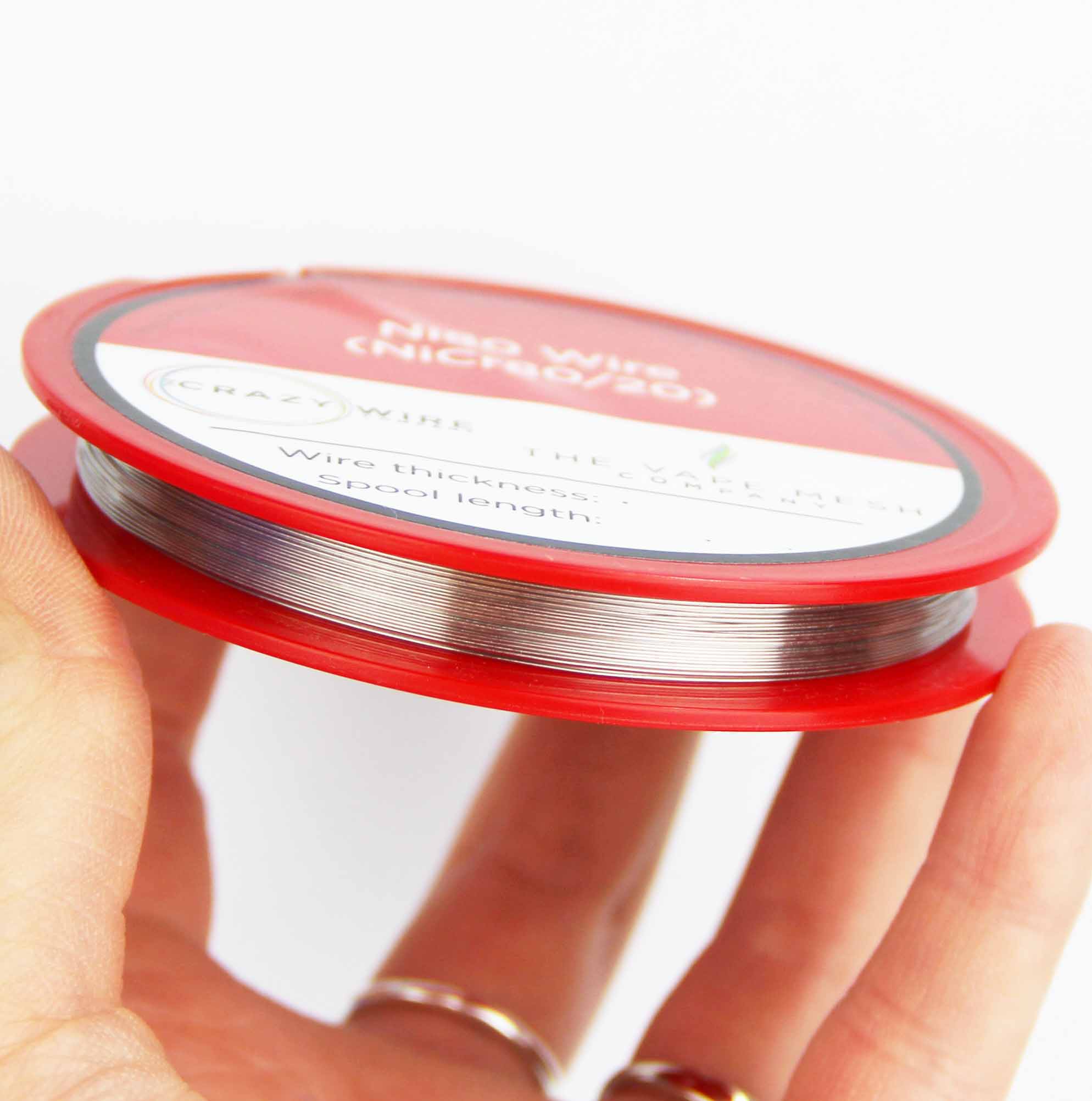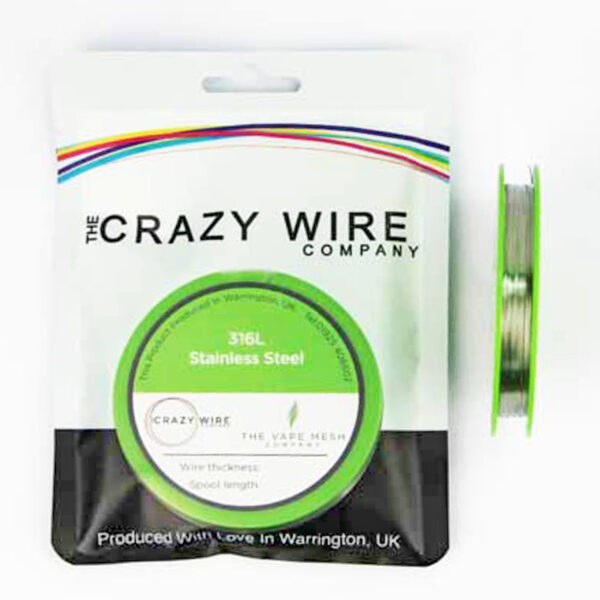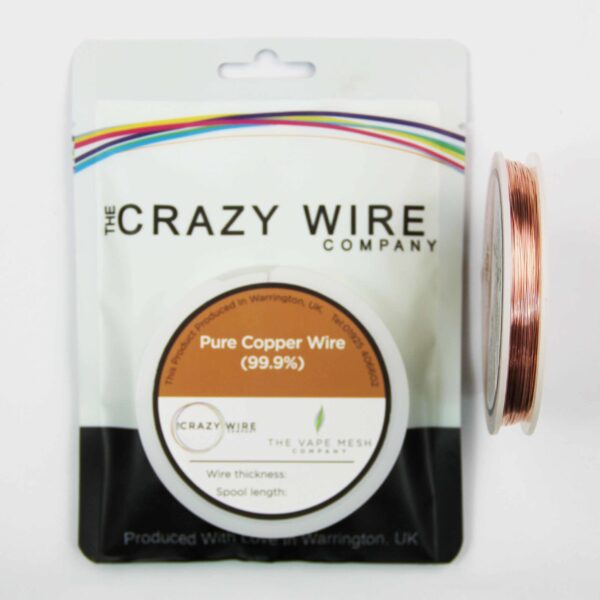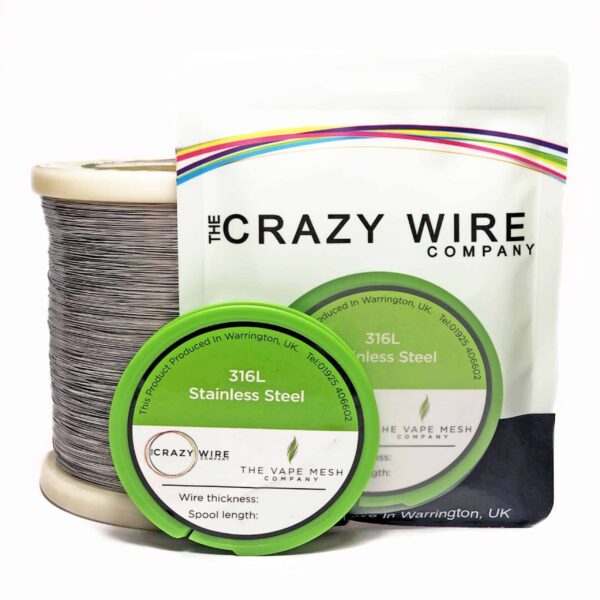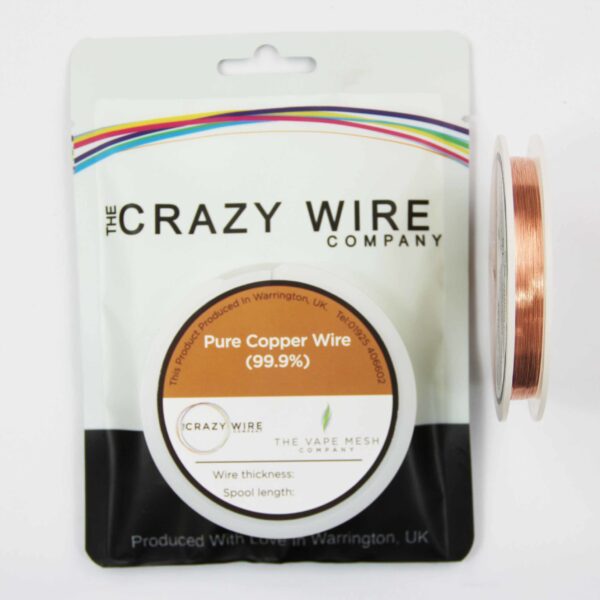Description
Nichrome Round Wire
The Crazy Wire Company are well known as suppliers of top quality nichrome round wire. We have enormous stock levels at all times, as we use this wire to weave our high specification woven mesh products. Our brilliant staff are experts in producing our spools of round wire on our 6 rapid action winding machines. All spools are produced to carry a little extra length to make up for any waste when handling the product.
Because we produce our own spools we are able to offer a wide choice of AWG and lengths. We are also able to guarantee the best prices in Europe.
Nichrome 80 round wire is a type of nichrome wire that is commonly used in heating elements, such as those found in toasters, hair dryers, and electric heaters. The “80” in its name refers to the percentage of nickel in the alloy, which is usually around 80%. The rest of the alloy is typically made up of chromium and other metals, such as iron. Nichrome 80 round wire is known for its high resistance to heat and high melting temperature, making it an ideal choice for use in heating applications where reliability and durability are important.
Key product details:
- Diameter – 1.15mm (1150 Micron – 17 AWG)
- Ohms/m – 0.98
- Technical Specification:
- Ni – Rest
- Cr – 20.0 – 23.0
- Fe – <1.0
- Max Continuous Service Temp Of Element – 1200
- Micrographic Structure – Austenite
- Magnetic Properties – Nonmagnetic
- Electrical resistance is high
- Corrosion resistance is high
Available Ni80 Wire Options
- 0.025mm – 50AWG – 2228 Ωm
- 0.05mm – 44AWG – 578 Ωm
- 0.06mm – 42AWG – 400 Ωm
- 0.07mm – 41AWG – 287 Ωm
- 0.08mm – 40AWG – 216.7 Ωm
- 0.09mm – 39AWG – 173.28 Ωm
- 0.1mm – 38AWG – 139.87 Ωm
- 0.12mm – 36AWG – 85 Ωm
- 0.125mm – 36AWG – 88.82 Ωm
- 0.13mm – 36AWG – 85.4 Ωm
- 0.14mm – 35AWG – 70.81 Ωm
- 0.15mm – 35AWG – 62.42 Ωm
- 0.16mm – 34AWG – 54.21 Ωm
- 0.17mm – 34AWG – 48.02 Ωm
- 0.18mm – 33AWG – 42.83 Ωm
- 0.2mm – 32AWG – 35.58 Ωm
- 0.21mm – 32AWG – 32.33 Ωm
- 0.23mm – 31AWG – 26.46 Ωm
- 0.25mm – 30AWG – 21.94 Ωm
- 0.27mm – 29AWG – 18.73 Ωm
- 0.28mm – 29AWG – 17.82 Ωm
- 29mm – 29AWG – 16.5 Ωm
- 0.3mm – 29AWG – 15.69 Ωm
- 0.32mm – 28AWG – 13.6 Ωm
- 0.35mm – 28AWG – 11.21 Ωm
- 0.37mm – 27AWG – 10.14 Ωm
- 0.38mm – 27AWG – 9.61 Ωm
- 0.4mm – 26AWG – 8.71 Ωm
- 0.42mm – 26AWG – 7.87 Ωm
- 0.45mm – 25AWG – 6.85 Ωm
- 0.51mm – 24AWG – 5.37 Ωm
- 0.54mm – 23AWG – 4.76 Ωm
- 0.6mm – 22AWG – 3.89 Ωm
- 0.64mm – 22AWG – 3.41 Ωm
- 0.7mm – 21AWG – 2.88 Ωm
- 0.8mm – 20AWG – 2.162 Ωm
- 0.9mm – 19AWG – 1.75 Ωm
- 1mm – 18AWG – 1.44 Ωm
- 1.15mm – 17AWG – 0.981 Ωm
Why Use The Crazy Wire Company
- Quality of products: The Crazy Wire Company always offer high-quality products that meet industry standards and customer expectations.
- Selection: We offer a wide variety of wire products and sizes to meet the diverse needs of our customers. We have more than 600 products available through our site and counting.
- Price: We always offer the best value possible. Our wires are available as part of our major weaving processes, so it is bought at the best possible rate.
- Availability: Our products are kept in house and are ready to ship immediately.
- Customer service: Our experienced staff help our customers feel confident in their purchases and provide assistance when required.
What Else Is Available?
We do not only offer Ni80 round wire. We also have a huge range of KA1 and stainless steel round wire in immediate stock too.
Ribbon wire and flat wire are stocked for immediate dispatch too.
FAQs About This Wire
How To Heat Nichrome Wire
Nichrome wire is typically heated by passing an electrical current through it. To heat nichrome wire, you need the following components:
- Power source: You can use a DC power supply or a battery to provide the electrical current to heat the nichrome wire.
- Resistor: To calculate the required resistance, you can use Ohm’s law: R = V / I, where R is the resistance, V is the voltage, and I is the current.
- Switch: A switch can be used to turn the electrical current on and off as needed.
- Nichrome wire: The wire is connected to the power source and the resistor in a circuit.
- Heat sink: A heat sink is used to dissipate heat away from the nichrome wire and prevent overheating.
When the electrical current is turned on, it passes through the nichrome wire and heats it up. The amount of heat generated by the nichrome wire depends on the resistance of the wire, the voltage, and the current. It is important to use caution when heating nichrome wire, as high temperatures can cause fires or burn injuries. Always follow proper safety precautions and use a heat sink to prevent overheating.
How Do I Connect Nichrome Wire?
There are several methods for connecting Nichrome 80 wire, but some of the most common methods include soldering and crimping.
- Soldering: To connect nichrome 80 wire using soldering, you will need a soldering iron and a high-temperature solder. Clean the end of the nichrome wire to be soldered, apply a small amount of solder to the end, and then use the soldering iron to heat the nichrome wire and melt the solder. Touch the soldered end of the wire to the component you want to connect it to and hold it in place until the solder solidifies.
- Crimping: To connect nichrome 80 wire using crimping, you will need a crimping tool and a crimp connector. Strip a small portion of the insulation from the end of the nichrome wire, insert the wire into the crimp connector, and then use the crimping tool to crimp the connector tightly around the wire.
Regardless of the method you use, it is important to ensure that the connection is secure and will not come loose over time. In some cases, it may be necessary to use heat-shrink tubing or other types of insulation to protect the connection from heat and ensure safety.
How Do I Solder Nichrome Wire?
Here are the steps to solder nichrome wire:
- Gather materials: You will need a soldering iron, a high-temperature solder, and nichrome wire.
- Clean the wire: Clean the end of the nichrome wire that you want to solder by wiping it with a clean cloth.
- Tin the wire: Apply a small amount of high-temperature solder to the end of the nichrome wire. This is known as “tinning” the wire.
- Heat the wire and component: Use the soldering iron to heat the tinned end of the nichrome wire and the component that you want to join it to.
- Apply solder: Touch the tinned end of the nichrome wire to the component and apply a small amount of solder to the joint. The solder should melt and flow into the joint, connecting the nichrome wire to the component.
- Cool and inspect: Allow the joint to cool completely, and then inspect it to ensure that it is secure and free of any defects.
It is important to note that nichrome wire has a high resistance to heat and can be difficult to solder. It is recommended to use a high-temperature soldering iron and high-temperature solder, and to pre-tin the nichrome wire before attempting to join it to another component. Additionally, it is important to follow proper safety precautions and use proper ventilation when soldering nichrome wire.
What Is The AWG mm Conversion?
American Wire Gauge (AWG) is a standardized wire gauge system used in the United States to denote the diameter of electrical wire. The higher the AWG number, the smaller the wire diameter.
To convert from AWG to millimeters (mm), you can use the following conversion formula:
Diameter (mm) = 0.127mm × 92^((36-AWG)/39)
For example, if you have a wire that is 18 AWG, you can use the above formula to find that it has a diameter of 1.024 mm.
Keep in mind that the above formula is an approximation, as the actual wire diameter may vary slightly depending on the manufacturer and the specific type of wire.
Alternatively, you can find the AWG to mm conversion table online or in electrical reference books.
What Is Wire Gauge?
Wire gauge refers to the standard measurement of the diameter of a wire. The smaller the wire gauge number, the larger the wire diameter. For example, a 12 gauge wire is larger in diameter than a 14 gauge wire. Wire gauge is used to indicate the thickness of wire used in electrical wiring and construction projects. This can be important in determining the amount of current a wire can safely carry and the overall strength of the wire.
The wire gauge measurement ranges from 0 to 40. The gauge number 0 is the largest, with a diameter of 0.36 inches, while the gauge number 40 is the smallest, with a diameter of 0.0031 inches. In general, the lower the gauge number, the thicker and stronger the wire. Wires with lower gauge numbers, such as 10 or 12, are typically used for high power applications, such as in electrical systems for buildings and vehicles, while wires with higher gauge numbers, such as 20 or 22, are used for lower power applications, such as in electronic devices and small applianc
Check out our blog ‘what is nichrome’ for more information on ni80 wire in general. Our goal for our blogs and help guides is to answer as many questions as possible to help to explain the possibilities of mesh to our customers.
We also offer similar products through our highly popular eBay store, check us out there too.
Contact our team today if you have any questions at all. We are always really keen to help in any way that we can.

